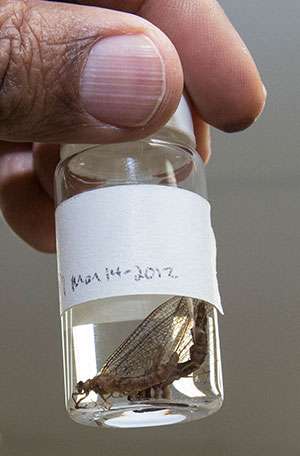Mayfly reintroduction to Michigan bay

Jerry Kaster's lifelong fascination with the mayfly could soon manifest itself in the most productive of ways: the successful re-establishment of an aquatic insect to the bay for which the animal was once named.
The bay is Lake Michigan's Green Bay, and Kaster – an associate professor in UWM's School of Freshwater Sciences – may be one experiment away from determining how best to reintroduce the mayfly to the place where it once swarmed and reproduced in such epic proportions that it was known as the Green Bay Fly.
If Kaster succeeds and the mayfly returns to the bay in the numbers before industrial pollution in the 1950s nearly wiped it out, so will a host of other life forms – including the walleye and other fish.
The disappearance of the insect, scientifically known as Hexagenia, has robbed the bay of what Kaster refers to as a once bustling "walleye factory."
That's why he and graduate student Christopher Groff are focused not on the fish that inhabit the water column, but on the relatively overlooked benthic, or bottom, ecosystem.
Getting to the bottom of the problem
The lake bottom is where they hope trillions of mayfly nymphs will burrow successfully someday soon, on their way through a gestational period that will conclude, above water, with a mating ritual that demonstrates just what an important food source the mayflies represent.
Mayflies spend all but about two days of their lives as nymphs burrowed in the bottom mud, but in those 48 hours as adults they congregate over the water, forming a swarm so large and thick that Doppler weather radars in the vicinity can mistake the hatch for a thunderstorm.
The mayflies conclude their terrestrial existence by mating over the water, dropping fertilized eggs in the process. "It's a crazy event," Kaster says, noting that a large mayfly hatch can release around 350,000 tons of protein into the food chain, where it is a feast for fish, birds, turtles and frogs.
"Limnoforming" is the word Kaster coined to describe the process he is using to determine whether the mud at the bottom of Green Bay – a soupy mixture due to the lack of sediment reworking by invertebrates stripped out by pollution – can be returned to a thickness that can physically support the burrows of mayfly nymphs.
The idea behind limnoforming, he says, is that a biologically complex community can be rebuilt from the ground up – starting with the right "pioneer" organisms that would modify the bottom mud to benefit mayfly survival.
"Invertebrate ecology is a largely overlooked, underrepresented part of the ecosystem, and it's extremely important to the healthy functioning of the rest of the system. What's living on the bottom drives production at higher levels," says Groff.
Tending to the benthic ecosystem first, Kaster believes, will quicken the pace of remediation of the whole bay.
As the worm turns…
Testing his theory involves not only the still-absent population of mayflies, but also another creature that should be inhabiting the bottom of the bay in greater numbers – tiny threadlike worms (aquatic cousins of earthworms) whose life cycles help thicken the mud.
In their research, funded by the National Oceanic and Atmospheric Administration (NOAA), Kaster and Groff are using thousands of Tubificidae worms harvested from the Kinnickinnic River in Milwaukee.
The researchers then deploy custom-made "worm condos" – enclosed microcosms containing the soupy Green Bay mud infused with worms – to test their effectiveness.
"The mayfly nymphs need to be able to create a burrow in the sediment, and we need it firm enough to support that," says Groff, who grew up in Fond du Lac and earned his undergraduate degree in biological sciences from UWM. "We're also hoping the worms increase the available oxygen content in the sediment, especially given the hypoxia [low oxygen] in Green Bay."
They are conducting a laboratory version of the experiment at the School of Freshwater Sciences as well.
If the worms succeed, the next step will be introducing mayfly eggs, and if those hatch and nymphs grow, the mayfly could be on its way back – along with an ecologically healthy lake bottom to support the Green Bay food web.
Of course, there is one potential mayfly in the ointment, so to speak: the public's response when the mayfly finally reclaims its nom de Green Bay Fly and trillions of them cover the landscape during mating season.
"The public may view this as a nuisance," says Kaster, "but the ecological and economic benefits will far outweigh human inconvenience."
Provided by University of Wisconsin-Madison


















